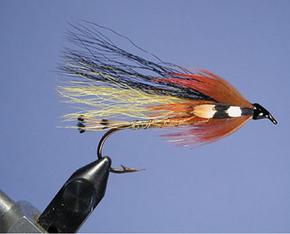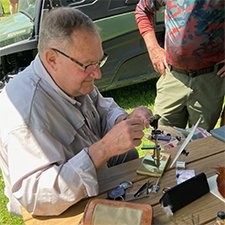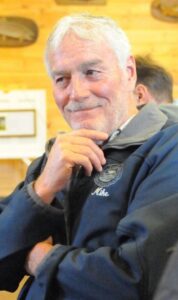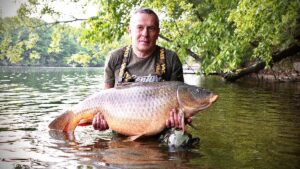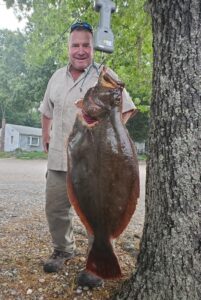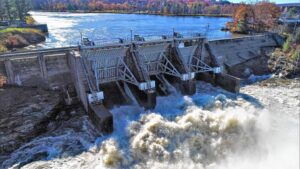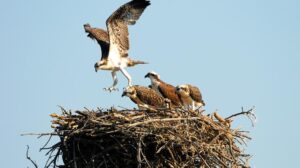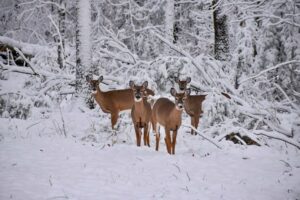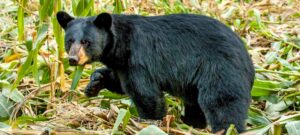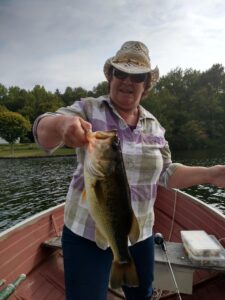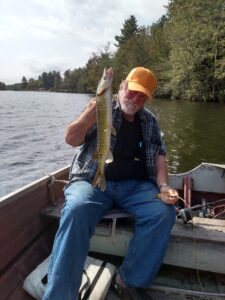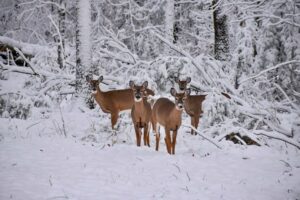This time of year is a good time to replenish trout flies that were lost last year. Like others, I have been wrapping furs and feathers onto hooks, concentrating primarily on flies to be used on our trip to the Catskills again this year. The Catskill rivers are famed as being the Birthplace of American Fly-Fishing and are home to some of the best fly fishing waters in the Northeast, visited by avid anglers from around the world. In my September, 2023 article chronicling a 4-day flyfishing trip to the Catskills that Paul Knauth (Hinsdale) and I made last September. In addition to writing about how a big trout cleaned my clock, I mentioned that we met several interesting people on that trip and that I would be mentioning them in a future column. Here it is:
When we checked into the Roscoe Motel in Roscoe, NY, we discovered that the annual Catskill Rod Makers’ Gathering (meeting of bamboo rod makers) had just wrapped up its gathering the day before our arrival. Incidentally, it is important that they be called rod makers and not rod builders. Rod makers make the blanks that they turn into rods. Rod builders start with the blanks and finish out the rods. Anyways, around 100 craftsmen attended, and after it was over some stayed a couple of extra days at the Roscoe Motel to do some flyfishing.
Rod makers are a patient breed. Can you imagine the work involved in: obtaining a section of bamboo cane or culm (the cylindrical, hollow stem) from the Tonkin Bay area, splitting it, planing it down, gluing the sections, separating it into two or three pieces, attaching the ferrules, guides and tip, varnishing it, heating it, building and attaching the cork handle, adding the reel seat and rings, and ultimately turning it into a beautiful, well balanced bamboo rod? Some say that around 400 separate operations go into building a bamboo rod.
Because Paul and I both own and frequently fish with cane rods, we made acquaintances with those cane makers who stayed at the motel. (Forgive me for some name dropping here.)
Several of them were interesting folks, for example Kim and Robert “Willis” Reid from Sharon, MA. They have been attending the Rod Makers Gatherings for many years but covid and other troubles had kept them away for a few years. Years ago, they spent their honeymoon staying at the Roscoe Motel and return every year at the same time. Kim has been the recipient of the A.P. Bellinger Award which is given annually to a person “for recognition of the recipient’s contribution to the bamboo rod makers’ craft and demonstrating that quality and integrity never go out of style.” She has been an illustrator for several books related to fly fishing.
Willis and I had a couple of nice conversations and one day he gave me one of his excellently tied flies named the Miller River Special. It was named after the Miller River in Massachusetts, not too far from where they live. Because Robert is a fly tyer of some renown, I don’t intend to fish with that fly but rather encase and display it.
There we met Dwight Adkinson of Virginia who happened to be fishing there that weekend. He is retired and seems to fish whenever and wherever he wants, places like the Balkans, Iceland, Scotland and Ireland.
One morning, while having breakfast, Paul, Dwight and I met renowned Catskill fly tyer Tom Mason and equally renowned cane rod maker Mike Canazon at the Kasos Greek Restaurant in Roscoe. Tom and Mike are volunteers at the Catskills Fly Fishing Center & Museum (CFFCM). Both carry the torch of the famed, classic Catskill tiers. We had a nice chat and before our conversations were over, Tom gave each of us two of his handsomely tied flies. My flies will also be encased.
Tom is a founding member and past president of the Catskill Fly Tyers Guild and has been instrumental in organizing numerous fly tying events including the Fly Tyers Rendezvous, Fly Fest, and the Fly Tyers Roundtable. Tom even ties his flies using hooks and materials from the golden era of flyfishing in the Catskills (1800’s). While he is generally acknowledged as being one of the finest tyers in the traditional Catskill style, he has taken the art to a new level with lightly hackled, almost ethereal flies.
Tom is a fixture on the Catskill rivers and around campfires telling fish tales that stretched the bounds of credulity. In addition to an amazing collection of books, bamboo rods, and reels, Tom also has an extensive collection of rare tying materials that enable him to reproduce flies tied by the old masters. Additionally, he helps lead the “Dream Team” of volunteer archivists that have spent several years preparing an online database showcasing all the items that the Catskill Fly Fishing Center & Museum (CFFCM) has acquired for its permanent collection over the past several decades.
Mike Canazon, of Livingston Manor, NY, was a well-known Catskill fly fisherman and master bamboo rod maker. He was very active in the CFFCM) and has taught bamboo rod making classes there. He also did a lot of the organizing for the Catskill Rod Makers Gatherings. He was inducted as a CFFCM Catskill Legend in 2022 and received the 2023 Gold Micrometer Award. He also received the A.P. Bellinger Award and was featured in the acclaimed movie, Land of Little Rivers”, a quintessential film of the places and famous anglers, that once more put the Catskills in the limelight as a fly fishing destination. I highly recommend this film.
Sadly, he passed away this past December at the age of 72. “There’s something about standing in the river, just being part of the world around you. You’re one small piece of that. Catching fish put me in the water, but now the water’s in me.” Mike once said.
Paul and I met Brian Greer, a respected bamboo rod maker from Missouri who attends the Rod Maker’s Gathering every year. He was born in the Ozarks and grew up fishing those spring creeks. He learned to make rods from a man named Harry Boyd from Louisiana and who is famous in the rod making community and who has written the book on making a bamboo rod blank. Now, Brian makes traditional, six-sided rods by hand and uses an old block plane to make his rod strips.
One time at the Gathering, the challenge contest rod for that year was to make a one-piece, 7’, 4wt rod. Brian let Dwight try out that rod and he really liked it. Dwight contacted him later that year and asked him to make him one. No surprise there. Paul and I got to cast a couple of Brian’s custom-made fly rods on the lawn of the Roscoe Motel and they were beautifully made and cast wonderfully. Truly works of art.
We met Noel Hudson, a friend of Brian’s who he first met just outside of the Smoky Mountains at a bamboo rod gathering there. Noel travels far and wide in his van, fishing along the way.
One night Paul and I returned to the motel after I missed a large brown trout due to an improper fishing line/backing connection. Before I knew it, Noel, Brian and Dwight took matters into their own hands and did some splicing, knot tying and stuff to my line and backing to correct the problem. So nice of them for they barely knew me. Folks are like that down there in the Catskills.
And are they knowledgeable. One night I showed them a cane flyrod that I had brought along on the trip. It had no maker’s name on the rod and I often wondered who made it. When these guys put their heads together for a minute or two, they determined that it was made by Partridge of Redditch (English).
For a couple of older flyfishermen like Paul and me, who enjoy the traditions of bamboo rods, the hallowed waters of the Catskills and their legendary anglers, fly tyers and rod makers, this trip was most satisfying. The folks there made us feel right at home, and God willing, we plan to link up with them again this summer.

